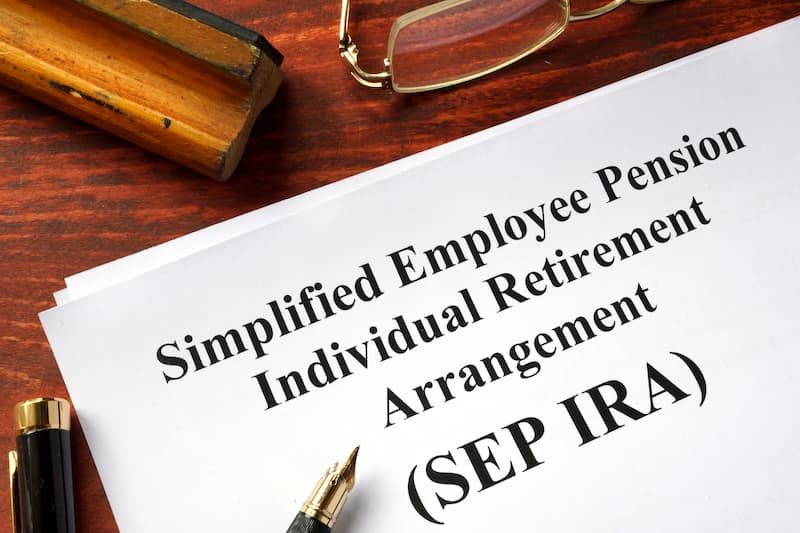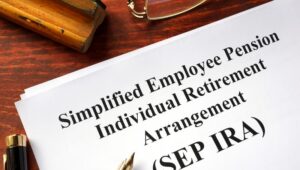Updated: July 2025
Building a nest egg for retirement is critical to your financial security, but where do you start? As a small business owner or self-employed individual, a Simplified Employee Pension (SEP) IRA allows you to maximize tax-advantaged retirement contributions far beyond a traditional IRA. You owe it to yourself and your employees to consider a SEP IRA.
With a SEP IRA, you can sock away up to 25% of your compensation or $70,000 per year, whichever is less, in 2025. Your contributions are tax deductible, reducing your taxable business income. And your employees’ accounts grow tax deferred, allowing them to benefit from decades of compounded returns. Best of all, a SEP IRA is simple to establish and maintain with minimal paperwork and costs.
Recent enhancements have made SEP IRAs even more attractive, with the addition of Roth options and new penalty-free withdrawal provisions that provide greater flexibility for you and your employees.
Do you want an easy, high-impact way to build wealth for your own retirement and provide an attractive employee benefit? Look no further than a SEP IRA. This powerful plan could be one of the smartest business and tax decisions you make.
How SEP IRAs Work
Small business owners and self-employed individuals, a SEP IRA may be an excellent retirement savings choice for you and your employees. With these plans, employers contribute to each employee’s traditional IRA account. Contributions are tax-deductible for the business and tax-deferred for employees until withdrawal in retirement.
With SEP IRAs, employers contribute a percentage of each employee’s salary directly into a traditional IRA opened for them. Employer contributions are tax-deductible as a business expense. And employee accounts grow tax-deferred until withdrawal in retirement when money is taxed as income.
Benefits of SEP IRAs
Two key benefits of SEP IRAs are higher contribution limits and tax advantages for both employers and employees. Employers can contribute significantly more than to Traditional IRAs alone. And their contributions are tax-deductible. For employees, contributions grow tax-deferred for tax-savings later. SEP IRAs also have low administrative costs, as employers handle most of the paperwork.
SEP IRAs offer high contribution limits, tax benefits, and flexibility:
- Tax deductible contributions: Contributions up to $70,000 per year are tax deductible for your business in 2025.
- Much higher limits: You can contribute up to 25% of compensation or $70,000 per year, whichever is less. Far more than allowed for IRAs or 401(k) plans.
- New Roth option: Starting in 2023, employers can offer Roth-treated contributions to SEP IRAs, allowing employees to choose between pre-tax and after-tax contributions for tax-free qualified withdrawals in retirement.
- Tax-deferred growth: Investments grow tax deferred for potentially decades. Your money can compound faster as a result.
- Easy to set up and maintain: Simple to establish with minimal compliance requirements. Low administrative costs compared to other plans.
- Discretionary contributions: You decide annually how much to contribute for yourself and your employees based on business conditions.
- Enhanced penalty-free withdrawals: Starting in 2024, new exceptions allow penalty-free withdrawals for domestic abuse victims (up to $10,000) and emergency personal expenses (up to $1,000 annually).
- Rollovers permitted: Employees can roll over balances from other retirement accounts into their SEP IRA when they leave your firm.
New Roth SEP IRA Option
A significant enhancement to SEP IRAs is the addition of Roth options starting in 2023:
- Employee choice: Employees can elect to have their SEP contributions treated as Roth (after-tax) rather than traditional (pre-tax)
- Tax treatment: Roth SEP contributions are included in the employee’s current taxable income but grow tax-free
- Qualified withdrawals: Roth SEP withdrawals are tax-free in retirement if requirements are met
- Payroll implications: Roth SEP contributions are subject to income tax and payroll tax withholding
- W-2 reporting: Roth SEP amounts must be properly reported on Form W-2 with appropriate tax withholding
How to Set Up a SEP IRA Plan
To establish a SEP IRA plan, employers fill out IRS Form 5305-SEP. They must provide plan details and open a traditional IRA for each employee where contributions will be deposited. Most major brokers can assist with setting up SEP IRA plans and accounts.
If you’re considering adding the Roth option, you’ll need to update your plan document, payroll systems, and employee election forms to accommodate both traditional and Roth contributions.
Contribution Limits and Rules
In 2025, employers can contribute up to the lesser of 25% of employee compensation or $70,000 to each employee’s SEP IRA. The compensation cap for calculating the 25% limit is $350,000 for 2025. But all eligible employees must receive the same contribution percentage. Employees cannot contribute to their own SEP IRA. The employer controls all contributions with discretion over the amount and frequency.
Employer contributions to SEP IRAs are discretionary but must follow certain rules:
- Contribution limits: You can contribute up to 25% of compensation or $70,000 per employee in 2025, whichever is less. Contributions are tax deductible for your business.
- Compensation cap: The maximum compensation that can be considered for the 25% calculation is $350,000 for 2025.
- Qualifying compensation: Compensation includes employee salary, wages, bonuses, and commissions but not necessarily all forms of compensation. Check what qualifies for your plan.
- Contribution timing: Contributions must be made through your tax-filing deadline, including extensions. So you have time to determine how much you can contribute for the year based on business results.
- Uniform percentage: You must contribute the same percentage of pay for all eligible employees, including yourself. But you can use separate contribution percentages for different time periods.
- Eligibility requirements: Employees must meet the minimum age (21) and earnings ($750 for 2024-2025) requirements to receive contributions for the year.
- Immediate vesting: Employees are immediately 100% vested in all SEP IRA contributions, meaning they own the total account balance.
- Early withdrawal penalties: Withdrawals before age 59½ generally face a 10% federal penalty tax, though new exceptions apply for domestic abuse victims and emergency personal expenses.
New Penalty-Free Withdrawal Options
Starting in 2024, SEP IRA participants have access to new penalty-free withdrawal exceptions:
- Domestic abuse victims: Up to $10,000 (indexed for inflation) can be withdrawn penalty-free, with the ability to repay within 3 years
- Emergency personal expenses: Up to $1,000 per year can be withdrawn penalty-free for emergency expenses, with repayment options available within 3 years
- Repayment benefits: If amounts are repaid within 3 years, the distribution is treated as a rollover for tax purposes
- Narrow application: These exceptions apply only to specific, narrowly defined circumstances
Investment Options for Building Your SEP IRA
SEP IRAs offer similar investment choices as traditional IRAs like stocks, bonds, mutual funds, ETFs, and CDs. Employees manage the investments in their own accounts and should choose options suitable for their financial goals and risk tolerance. But employers control the overall SEP IRA plan.
- Mutual funds: Funds holding stocks, bonds or a mix provide growth and income potential with different risk levels. Review fees and historical returns for best outcomes.
- ETFs: Exchange traded funds track an index, sector or commodity. Low cost but you must buy and sell during market hours when prices may differ from net asset value.
- Annuities: Variable or fixed annuities offer tax-deferred growth and guaranteed income. Higher fees reduce returns but promise income you cannot outlive.
- Individual stocks and bonds: Buying individual securities provides the potential for higher returns at more risk. Only for knowledgeable investors.
- Certificates of deposit: CDs give very low risk and stable returns. Ideal for cash reserves in SEP IRAs as returns often do not beat inflation. Terms from 1 month to 5 years.
- Cash: High-yield savings accounts provide liquidity with low risk but returns may not exceed inflation over the long run.
Funding Your SEP IRA
Employers can fund SEP IRAs through a lump-sum deposit or periodic contributions over the course of the plan year. All contributions for a tax year must be deposited by the employer’s tax filing deadline for that year, including any extensions. Employees cannot contribute to their SEP IRA directly. All contributions must come from the employer according to the plan details.
If offering Roth options, employers must ensure proper payroll tax withholding and W-2 reporting for Roth contributions, as these are treated as taxable income to the employee.
Required Minimum Distribution Updates
Recent changes have affected RMD requirements for SEP IRAs:
- Starting age increased: RMDs now begin at age 73 (increased from 72) for those born in 1951 or later
- Reduced penalties: The penalty for missed RMDs has been reduced from 50% to 25% of the missed amount
- Correction opportunity: If corrected within 2 years, the penalty can be further reduced to just 10%
- Future increase: The RMD age will increase to 75 in 2033 for those born in 1960 or later
Mitigating Risks and Optimizing Returns
To optimize a SEP IRA, diversify investments and maintain a long-term view. While there’s potential for loss, historically, stocks have provided the best returns over time. So consider allocating a portion of the SEP IRA to stock funds. Also, compare fees for investment options and the plan overall to keep more money working for the future. Lower fees mean better growth potential.
Plan Compliance and Administration
Recent legislation has provided more time for plan updates:
- Amendment deadline: SECURE 2.0 extended the deadline for amending SEP documents to reflect law changes to December 31, 2026
- Document updates: Custodians and employers have more time to update Form 5305-SEP or prototype documents
- Annual review: Continue to review employee eligibility each year based on the $750 minimum compensation threshold
- Payroll system updates: If offering Roth options, ensure payroll systems properly handle elections and tax withholding
Risk and Returns
While SEP IRAs allow tax-advantaged retirement saving and investing, your account balance can decline if markets drop.
Balancing your investments across holdings that suit your risk tolerance and goals gives the strongest odds of building wealth over time. But also make sure to keep fees low, especially on higher risk options, so more of your money remains working for you. Develop an investment plan with the help of your custodian and financial advisors, if needed, for the best SEP IRA results based on your objectives and timeline. Then revisit your choices each year to ensure your strategy continues aligning with your evolving needs. The power of tax advantaged compounding returns will build your balance over years if maximizing contributions and prudent investing.
Conclusion
You now have a solid overview of how SEP IRAs work and why they benefit small business owners and the self-employed. The potential to sock away up to 25% of your compensation—up to $70,000 in 2025—makes these plans extremely attractive for maximizing tax-advantaged retirement wealth. And with minimal administrative burden, SEP IRAs let you focus on growing your business.
Recent enhancements have made SEP IRAs even more powerful. The addition of Roth options provides tax diversification opportunities, while new penalty-free withdrawal provisions offer greater flexibility for emergency situations. Enhanced RMD rules provide additional time for tax-deferred growth, and extended amendment deadlines give you more time to implement these beneficial changes.
Don’t delay in establishing a SEP IRA. Open the plan today to start reaping the rewards of tax-deductible contributions and decades of tax-deferred growth. Consider whether the new Roth option might benefit you and your employees. Fund your SEP IRA consistently and maximize contributions whenever possible. Choose a balanced investment approach suited to your goals and risk tolerance. Keep fees low. Do this, and a SEP IRA could provide the nest egg that lets you pursue your dreams in retirement. The power of compounding returns and time are on your side. Put them to work through a SEP IRA and secure your future.











